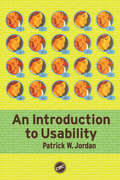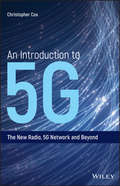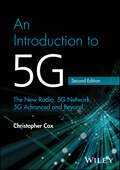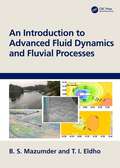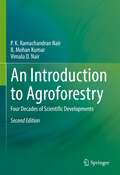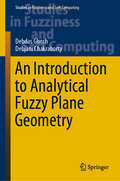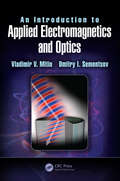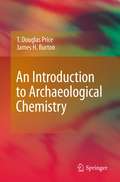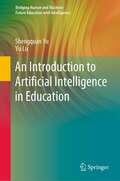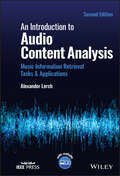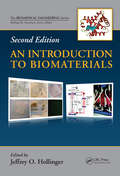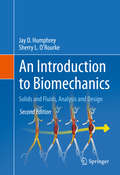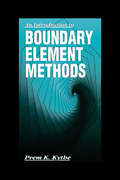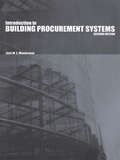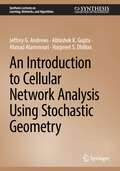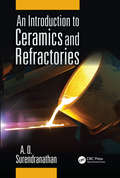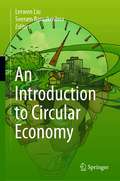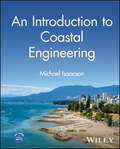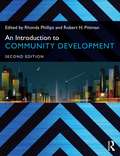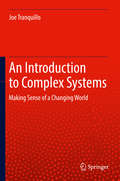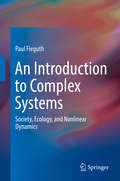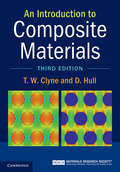- Table View
- List View
An Introduction To Usability
by Patrick W. JordanThis work gives a broad introductory overview of the topic of usability. Firstly, usability is defined and a framework for identifying different aspects of usability is given. The main principles for creating usable designs are expounded, followed by practical advice as to how to design usable products. The book then tackles the issue of usability evaluation - a series of evaluation methods are described, followed by practical advice as to how to conduct the evaluation. The book draws on examples from software design and product design generally. This means whilst human-computer interaction HCI is a central issue in the book, other usability issues are also covered.
An Introduction to 5G: The New Radio, 5G Network and Beyond
by Christopher CoxA comprehensive and approachable introduction to 5G Written by a noted expert on the subject, An Introduction to 5G: The New Radio, 5G Network and Beyond offers an introductory system-level guide to 5G. The material covered includes: The use cases and requirements of the 5G system The architecture of the next generation radio access network and the 5G core The principles of radio transmission, millimetre waves and MIMO antennas The architecture and detailed design of the 5G new radio The implementation of HTTP/2 on the service-based interfaces of the 5G core The signalling procedures that govern the end-to-end-operation of the system The new features that are introduced in Releases 16 and 17 An Introduction to 5G is written for engineering professionals in mobile telecommunications, for those in non-technical roles such as management, marketing and intellectual property, and for students. It requires no more than a basic understanding of mobile communications, and includes detailed references to the underlying 3GPP specifications for 5G. The book's approach provides a comprehensive, end-to-end overview of the 5G standard, which enables readers to move on with confidence to the more specialized texts and to the specifications themselves.
An Introduction to 5G: The New Radio, 5G Network, 5G Advanced and Beyond
by Christopher CoxA comprehensive and approachable introduction to 5G and 5G-Advanced Written by a noted expert on the subject, this Second Edition of An Introduction to 5G delivers a comprehensive, system-level guide to 5G and 5G-Advanced. Building on the foundations laid in the First Edition, the topics explored include the market and use cases for 5G-Advanced; the architectures of the next generation radio access network, open radio access networks and the 5G core; the principles of radio transmission, millimeter waves and MIMO antennas; the architecture and operation of the 5G New Radio; the implementation of network function services by means of HTTP/2; and the signaling procedures that govern the end-to-end operation of the system. This Second Edition has been thoroughly expanded and updated for 3GPP Release 18, to cover the new capabilities introduced under the name of 5G-Advanced. There are new chapters on: The foundations of 5G-Advanced, including non-terrestrial networks, multicast/broadcast services, wireless backhauling, unlicensed spectrum, and artificial intelligence and machine learningThe Internet of Things, including time-sensitive communications, non-public networks, edge computing, and massive machine-type communicationsDevice-to-device communications on the 5G sidelink, in support of vehicle, aircraft and proximity-based servicesThe new features being introduced in 3GPP Release 19, and the expected applications, technologies and performance capabilities of 6G An Introduction to 5G is written for engineering professionals in mobile telecommunications, for those in non-technical roles such as management, marketing and intellectual property, and for students. It requires no more than a basic understanding of mobile communications, and includes detailed references to the underlying 3GPP specifications for 5G. The book’s approach provides a comprehensive, end-to-end overview of the 5G standard, which enables readers to move on with confidence to the more specialized texts and to the specifications themselves.
An Introduction to Advanced Fluid Dynamics and Fluvial Processes
by B. S. Mazumder T. I. EldhoThis book covers fluid dynamics and fluvial processes, including basics applicable to open channel flow followed by turbulence characteristics related to sediment-laden flows. It presents well-balanced exposure of physical concepts, mathematical treatments, validation of the models/theories, and experimentations using modern electronic gadgets within the scope. In addition, it explores fluid motions, sediment-fluid interactions, erosion and scouring, sediment suspension and bed load transportation, image processing for particle dynamics, and various problems of applied fluid mechanics in natural sciences. Features: Gives comprehensive treatment on fluid dynamics and fluvial process from fundamentals to advanced level applications in one volume. Presents knowledge on sediment transport and its interaction with turbulence. Covers recent methodologies in the study of turbulent flow theories with verification of laboratory data collected by ADV, PIV, URS, LDA, and imaging techniques, and field data collected by MMB and S4 current meters. Explores the latest empirical formulae for the estimations of bed load, saltation, suspension, and bedform migration. Contains theory to experimentations with field practices with comprehensive explanations and illustrations. This book is aimed at senior undergraduates, engineering and applied science postgraduate and research students working in mechanical, civil, geo-sciences, and chemical engineering departments pertaining to fluid mechanics, hydraulics, sediment transportation, and turbulent flows.
An Introduction to Agroforestry: Four Decades of Scientific Developments
by Vimala D. Nair B. Mohan Kumar P. K. NairAgroforestry – the practice of growing trees and crops in interacting combinations – is recognized the world over as an integrated approach to sustainable land-use. Agroforestry systems, being multifunctional, facilitate not only the production of food and wood products but also provide a variety of ecosystem services such as climate-change mitigation, biodiversity conservation, and soil quality improvement. Agroforestry research has made rapid strides since organized efforts started in the late 1970s. Today, a vast body of scientific knowledge and an impressive array of publications on agroforestry are available. Four World Congresses on Agroforestry conducted once every five years since 2004 have brought together the global community of agroforestry professionals and practitioners to share and discuss the emerging trends and paradigm shifts in this field. The fifth Congress is scheduled to be held in Québec, Canada. However, a comprehensive college-level textbook incorporating these research findings did not exist until this book was first published. The first edition of this book in 1993 (Nair, P. K. R., 1993) is out of print and somewhat dated. This revised edition, with emphasis on the scientific developments during the past more than four decades, addresses this long-felt need.
An Introduction to Analytical Fuzzy Plane Geometry (Studies in Fuzziness and Soft Computing #381)
by Debdas Ghosh Debjani ChakrabortyThis book offers a rigorous mathematical analysis of fuzzy geometrical ideas. It demonstrates the use of fuzzy points for interpreting an imprecise location and for representing an imprecise line by a fuzzy line. Further, it shows that a fuzzy circle can be used to represent a circle when its description is not known precisely, and that fuzzy conic sections can be used to describe imprecise conic sections. Moreover, it discusses fundamental notions on fuzzy geometry, including the concepts of fuzzy line segment and fuzzy distance, as well as key fuzzy operations, and includes several diagrams and numerical illustrations to make the topic more understandable. The book fills an important gap in the literature, providing the first comprehensive reference guide on the fuzzy mathematics of imprecise image subsets and imprecise geometrical objects. Mainly intended for researchers active in fuzzy optimization, it also includes chapters relevant for those working on fuzzy image processing and pattern recognition. Furthermore, it is a valuable resource for beginners interested in basic operations on fuzzy numbers, and can be used in university courses on fuzzy geometry, dealing with imprecise locations, imprecise lines, imprecise circles, and imprecise conic sections.
An Introduction to Applied Electromagnetics and Optics
by Vladimir V. Mitin Dmitry I. SementsovModern technology is rapidly developing and for this reason future engineers need to acquire advanced knowledge in science and technology, including electromagnetic phenomena. This book is a contemporary text of a one-semester course for junior electrical engineering students. It covers a broad spectrum of electromagnetic phenomena such as, surface waves, plasmas, photonic crystals, negative refraction as well as related materials including superconductors. In addition, the text brings together electromagnetism and optics as the majority of texts discuss electromagnetism disconnected from optics. In contrast, in this book both are discussed. Seven labs have been developed to accompany the material of the book.
An Introduction to Archaeological Chemistry
by T. Douglas Price James H. BurtonArchaeological chemistry is a subject of great importance to the study and methodology of archaeology. This comprehensive text covers the subject with a full range of case studies, materials, and research methods. With twenty years of experience teaching the subject, the authors offer straightforward coverage of archaeological chemistry, a subject that can be intimidating for many archaeologists who do not already have a background in the hard sciences. With clear explanations and informative illustrations, the authors have created a highly approachable text, which will help readers overcome that intimidation. Topics covered included: Materials (rock, pottery, bone, charcoal, soils, metals, and others), Instruments (microscopes, NAA, spectrometers, mass spectrometers, GC/MS, XRF & XRD, Case Studies (Provinience, Sediments, Diet Reconstruction, Past Human Movement, Organic Residues). The detailed coverage and clear language will make this useful as an introduction to the study of archaeological chemistry, as well as a useful resource for years after that introduction.
An Introduction to Artificial Intelligence in Education (Bridging Human and Machine: Future Education with Intelligence)
by Shengquan Yu Yu LuThis book systematically reviews a broad range of cases in education that utilize cutting-edge AI technologies. Furthermore, it introduces readers to the latest findings on the scope of AI in education, so as to inspire researchers from non-technological fields (e.g. education, psychology and neuroscience) to solve education problems using the latest AI techniques. It also showcases a number of established AI systems and products that have been employed for education. Lastly, the book discusses how AI can offer an enabling technology for critical aspects of education, typically including the learner, content, strategy, tools and environment, and what breakthroughs and advances the future holds.The book provides an essential resource for researchers, students and industrial practitioners interested and engaged in the fields of AI and education. It also offers a convenient handbook for non-professional readers who need a primer on AI in education, and who want to gain a deeper understanding of emerging trends in this domain.
An Introduction to Audio Content Analysis: Music Information Retrieval Tasks and Applications
by Alexander LerchAn Introduction to Audio Content Analysis Enables readers to understand the algorithmic analysis of musical audio signals with AI-driven approaches An Introduction to Audio Content Analysis serves as a comprehensive guide on audio content analysis explaining how signal processing and machine learning approaches can be utilized for the extraction of musical content from audio. It gives readers the algorithmic understanding to teach a computer to interpret music signals and thus allows for the design of tools for interacting with music. The work ties together topics from audio signal processing and machine learning, showing how to use audio content analysis to pick up musical characteristics automatically. A multitude of audio content analysis tasks related to the extraction of tonal, temporal, timbral, and intensity-related characteristics of the music signal are presented. Each task is introduced from both a musical and a technical perspective, detailing the algorithmic approach as well as providing practical guidance on implementation details and evaluation. To aid in reader comprehension, each task description begins with a short introduction to the most important musical and perceptual characteristics of the covered topic, followed by a detailed algorithmic model and its evaluation, and concluded with questions and exercises. For the interested reader, updated supplemental materials are provided via an accompanying website. Written by a well-known expert in the music industry, sample topics covered in Introduction to Audio Content Analysis include: Digital audio signals and their representation, common time-frequency transforms, audio features Pitch and fundamental frequency detection, key and chord Representation of dynamics in music and intensity-related features Beat histograms, onset and tempo detection, beat histograms, and detection of structure in music, and sequence alignment Audio fingerprinting, musical genre, mood, and instrument classification An invaluable guide for newcomers to audio signal processing and industry experts alike, An Introduction to Audio Content Analysis covers a wide range of introductory topics pertaining to music information retrieval and machine listening, allowing students and researchers to quickly gain core holistic knowledge in audio analysis and dig deeper into specific aspects of the field with the help of a large amount of references.
An Introduction to Biomaterials (Biomedical Engineering)
by Jeffrey O. HollingerA practical road map to the key families of biomaterials and their potential applications in clinical therapeutics, Introduction to Biomaterials, Second Edition follows the entire path of development from theory to lab to practical application. It highlights new biocompatibility issues, metrics, and statistics as well as new legislation for intelle
An Introduction to Biomechanics: Solids and Fluids, Analysis and Design
by Jay D. Humphrey Sherry L. O'RourkeThis book covers the fundamentals of biomechanics. Topics include bio solids, biofluids, stress, balance and equilibrium. Students are encouraged to contextualize principles and exercises within a "big picture" of biomechanics. This is an ideal book for undergraduate students with interests in biomedical engineering.
An Introduction to Biomechanics: Solids and Fluids, Analysis and Design
by Jay D. Humphrey Sherry L. O’RourkeThis textbook introduces the student to a consistent approach of formulating and solving problems involving the biomechanics of solids and fluids. Brief introductions are also provided for more complex situations that require methods of nonlinear elasticity, elastodynamics, viscoelasticity, or fluid-solid interactions. Concepts are motivated by concise descriptions of important biological, biomechanical, and clinical observations and techniques. Included are over 300 figures and 200 references, as well as complete derivations of the fundamental equations, solutions of over 100 example problems, and over 350 exercise problems. Perfect for a one- or two-semester introduction to biomechanics, this Third Edition includes expanded sections on complex fluid (non-Newtonian) and solid (nonlinear and anisotropic) behaviors as well as coupled problems for different tissues. Additional homework problems encourage the student to appreciate the broad applicability of the fundamental equations. An Introduction to Biomechanics, Third Edition is an ideal book for undergraduate students with interests in bioengineering, biomedical engineering, or biomechanical engineering, and serves as a valuable reference for graduate students, practicing engineers, and researchers. This book also: Guides students in developing intuitive understanding via a consistent consideration of diverse problems including cardiovascular, musculoskeletal, pulmonary, and cell mechanics Encourages students to develop a “big picture” approach to problem-solving in biomechanics through chapter summaries Challenges students to solve problems for conditions commonly experienced in the laboratory, industry, or the clinic
An Introduction to Biomedical Optics (Series in Optics and Optoelectronics)
by Robert Splinter Brett A. HooperMany universities now offer a course in biomedical optics, but lack a textbook specifically addressing the topic. Intended to fill this gap, An Introduction to Biomedical Optics is the first comprehensive, introductory text describing both diagnostic and therapeutic optical methods in medicine. It provides the fundamental background needed for grad
An Introduction to Boundary Element Methods (Symbolic And Numeric Computation Ser. #4)
by Prem K. KytheThe finite element and the boundary element methods are the two most important developments in numerical mathematics to occur in this century. Many engineering and mathematics graduate curricula now include a course in boundary element methods. Such a course must cover numerical methods, basic methodology to real problems, and interactive computer usage. Both theory and applications, necessary for applied courses, are available in this new textbook.An Introduction to Boundary Element Methods is logically organized and easy to read. The topics are carefully selected and meticulously presented. Applications are described for use in identifying potential problems and for heat transfer, diffusion equations, linear elasticity, water waves, ocean acoustics, acoustic scattering, aerodynamics, porous media, and simple laminar flows.More than 20 computer subroutines help develop and explain the computational aspect of the subject. Hundreds of figures, exercises, and solved examples supplement text and help clarify important information.The computer programs have been tested on some benchmark problems. Even in single precision the results are more accurate and better than those obtained from available Fortran programs.
An Introduction to Building Procurement Systems
by J.W.E. Masterman Dr Jack Masterman Jack MastermanFirst Published in 2003. Routledge is an imprint of Taylor & Francis, an informa company.
An Introduction to Cellular Network Analysis Using Stochastic Geometry (Synthesis Lectures on Learning, Networks, and Algorithms)
by Harpreet S. Dhillon Jeffrey G. Andrews Abhishek K. Gupta Ahmad AlammouriThis book provides an accessible yet rigorous first reference for readers interested in learning how to model and analyze cellular network performance using stochastic geometry. In addition to the canonical downlink and uplink settings, analyses of heterogeneous cellular networks and dense cellular networks are also included. For each of these settings, the focus is on the calculation of coverage probability, which gives the complementary cumulative distribution function (ccdf) of signal-to-interference-and-noise ratio (SINR) and is the complement of the outage probability. Using this, other key performance metrics, such as the area spectral efficiency, are also derived. These metrics are especially useful in understanding the effect of densification on network performance. In order to make this a truly self-contained reference, all the required background material from stochastic geometry is introduced in a coherent and digestible manner.This Book:Provides an approachable introduction to the analysis of cellular networks and illuminates key system dependenciesFeatures an approach based on stochastic geometry as applied to cellular networks including both downlink and uplinkFocuses on the statistical distribution of signal-to-interference-and-noise ratio (SINR) and related metrics
An Introduction to Ceramics and Refractories
by A. O. SurendranathanThis book covers the fundamental aspects of ceramics and refractories. All refractories are ceramics, but all ceramics are not refractories. The book classifies and describes these materials, and examines their availability in nature. It examines the availability of these materials in nature, how they are extracted from nature, and how some of these materials are synthesized, and explains their structure-property correlation. It also addresses how they are designed for various applications and more.
An Introduction to Circular Economy
by Seeram Ramakrishna Lerwen LiuThis book is purposefully styled as an introductory textbook on circular economy (CE) for the benefit of educators and students of universities. It provides comprehensive knowledge exemplified by practices from policy, education, R&D, innovation, design, production, waste management, business and financing around the world. The book covers sectors such as agriculture/food, packaging materials, build environment, textile, energy, and mobility to inspire the growth of circular business transformation. It aims to stimulate action among different stakeholders to drive CE transformation. It elaborates critical driving forces of CE including digital technologies; restorative innovations; business opportunities & sustainable business model; financing instruments, regulation & assessment and experiential education programs. It connects a CE transformation for reaching the SDGs2030 and highlights youth leadership and entrepreneurship at all levels in driving the sustainability transformation.
An Introduction to Coastal Engineering
by Michael IsaacsonUnderstand and respond to a changing coastline with this comprehensive reference Coastal engineering concerns society’s interactions with coastlines and relates, for example, to coastal flooding, beach erosion, seawalls and breakwaters, and the design of marinas. As climate change drives sea level rise, coastal engineering is critical in responding to increased coastal flooding and receding shorelines. The need to develop coastal infrastructure while minimizing environmental impacts makes this a vital field. An Introduction to Coastal Engineering offers a comprehensive overview of this subject, designed to bridge existing gaps in the general civil engineering literature. Covering all major aspects of coastal engineering, including ocean wave behaviour, structures, sediments, mixing processes, and modelling, the book emphasizes practical solutions and applications for students and practicing engineers alike. Thorough and rigorous, yet highly readable, the book is a must-own tool for developing solutions towards a sustainable coastal future. An Introduction to Coastal Engineering readers will also find: Pertinent descriptions of wave theories, wave transformations, and random wavesDetailed discussion of practical solutions, recent advancements in the field, and up-to-date data sourcesWorked-through examples and end-of-chapter problems with some written assignmentsA spreadsheet appendix containing a set of reference solutions An Introduction to Coastal Engineering is ideal for students in upper-level undergraduate and graduate courses in coastal engineering, practicing coastal engineers, and other engineers engaged in coastal flood protection, waterfront development projects, and the minimization of environmental impacts along shorelines.
An Introduction to Community Development
by Rhonda Phillips Robert PittmanBeginning with the foundations of community development, An Introduction to Community Development offers a comprehensive and practical approach to planning for communities. Road-tested in the authors’ own teaching, and through the training they provide for practicing planners, it enables students to begin making connections between academic study and practical know-how from both private and public sector contexts. An Introduction to Community Development shows how planners can utilize local economic interests and integrate finance and marketing considerations into their strategy. Most importantly, the book is strongly focused on outcomes, encouraging students to ask: what is best practice when it comes to planning for communities, and how do we accurately measure the results of planning practice? This newly revised and updated edition includes: increased coverage of sustainability issues, discussion of localism and its relation to community development, quality of life, community well-being and public health considerations, and content on local food systems. Each chapter provides a range of reading materials for the student, supplemented with text boxes, a chapter outline, keywords, and reference lists, and new skills based exercises at the end of each chapter to help students turn their learning into action, making this the most user-friendly text for community development now available.
An Introduction to Complex Systems: Making Sense of a Changing World
by Joe TranquilloThis book explores the interdisciplinary field of complex systems theory. By the end of the book, readers will be able to understand terminology that is used in complex systems and how they are related to one another; see the patterns of complex systems in practical examples; map current topics, in a variety of fields, to complexity theory; and be able to read more advanced literature in the field. The book begins with basic systems concepts and moves on to how these simple rules can lead to complex behavior. The author then introduces non-linear systems, followed by pattern formation, and networks and information flow in systems. Later chapters cover the thermodynamics of complex systems, dynamical patterns that arise in networks, and how game theory can serve as a framework for decision making. The text is interspersed with both philosophical and quantitative arguments, and each chapter ends with questions and prompts that help readers make more connections.
An Introduction to Complex Systems: Society, Ecology, and Nonlinear Dynamics
by Paul FieguthThis undergraduate text explores a variety of large-scale phenomena - global warming, ice ages, water, poverty - and uses these case studies as a motivation to explore nonlinear dynamics, power-law statistics, and complex systems. Although the detailed mathematical descriptions of these topics can be challenging, the consequences of a system being nonlinear, power-law, or complex are in fact quite accessible. This book blends a tutorial approach to the mathematical aspects of complex systems together with a complementary narrative on the global/ecological/societal implications of such systems. Nearly all engineering undergraduate courses focus on mathematics and systems which are small scale, linear, and Gaussian. Unfortunately there is not a single large-scale ecological or social phenomenon that is scalar, linear, and Gaussian. This book offers students insights to better understand the large-scale problems facing the world and to realize that these cannot be solved by a single, narrow academic field or perspective. Instead, the book seeks to emphasize understanding, concepts, and ideas, in a way that is mathematically rigorous, so that the concepts do not feel vague, but not so technical that the mathematics get in the way. The book is intended for undergraduate students in a technical domain such as engineering, computer science, physics, mathematics, and environmental studies.
An Introduction to Composite Materials
by D. Hull T. W. ClyneThis new edition has been greatly enlarged and updated to provide both scientists and engineers with a clear and comprehensive understanding of composite materials. In describing both theoretical and practical aspects of their production, properties and usage, the book crosses the borders of many disciplines. Topics covered include: fibers, matrices, laminates and interfaces; elastic deformation, stress and strain, strength, fatigue crack propagation and creep resistance; toughness and thermal properties; fatigue and deterioration under environmental conditions; fabrication and applications. Coverage has been increased to include polymeric, metallic and ceramic matrices and reinforcement in the form of long fibers, short fibers and particles. Designed primarily as a teaching text for final year undergraduates in materials science and engineering, this book will also interest undergraduates and postgraduates in chemistry, physics, and mechanical engineering. In addition, it will be an excellent source book for academic and technological researchers on materials.
An Introduction to Composite Materials (Cambridge Solid State Science Ser.)
by D. Hull T. W. ClyneThis fully expanded and updated edition provides both scientists and engineers with all the information they need to understand composite materials, covering their underlying science and technological usage. It includes four completely new chapters on surface coatings, highly porous materials, bio-composites and nano-composites, as well as thoroughly revised chapters on fibres and matrices, the design, fabrication and production of composites, mechanical and thermal properties, and industry applications. Extensively expanded referencing engages readers with the latest research and industrial developments in the field, and increased coverage of essential background science makes this a valuable self-contained text. A comprehensive set of homework questions, with model answers available online, explains how calculations associated with the properties of composite materials should be tackled, and educational software accompanying the book is available online. An invaluable text for final-year undergraduates in materials science and engineering, and graduate students and researchers in academia and industry.
